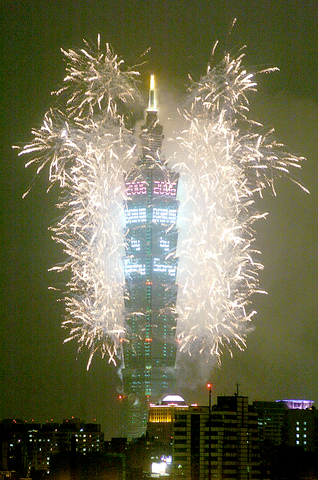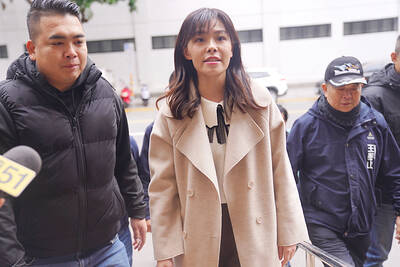On New Year's Eve last year, tens of thousands of revelers flooding the streets of Taipei Xinyi District were all excited to usher in the arrival of the new year.
When the clock ticked at 12am, the 128-second fireworks burst from the top floors of Taipei 101. People were not only enchanted by the fireworks, but also by a sentence projected on the world's tallest freestanding building.
The phrase "2006 Bravia by Sony" had caught everyone's attention, at the same time arousing curiosity among those who were not in the know.

TAIPEI TIMES FILE PHOTO
Chao Yi-chien (
The 22-year-old part-time tutor did not know the meaning of Bravia until she read news reports the following day.
Indeed, Japanese electronics giant Sony Corp managed to send its message across to potential clientele from all walks of life, and they are not limited to those in Taiwan.
The image of the world's tallest countdown was simultaneously broadcast by global media, such as the US' CNN, Japan's NHK and China Central Television.
The price reportedly paid to sponsor the fireworks was NT$20 million (US$60,661).
Taipei Financial Center Corp (TFCC, 台北金融大樓公司) operators have decided this year to push the price tag up to NT$30 million and prolong the fireworks display to 188 seconds.
"We want to break last year's record by showing a longer display of fireworks this time," TFCC assistant vice president Michael Liu (
"The firework countdown attracts international media attention and it is the biggest moment of the year for us," he said.
Already 10 companies have approached TFCC this year for possible firework sponsorship.
The list includes local and foreign big names in the computers, communications and consumer electronics industries. Even an automobile firm made contacts, he said.
Sony is definitely not missing out on the exposure this year.
Hiroyuki Oda, division president of Sony Taiwan Ltd, was all smiles last Wednesday when asked by media about the effect of last year's firework sponsorship.
"The impact was so much greater than we expected," he said.
All that the company initially wanted people to realize was that Bravia is the brandname of Sony's liquid-crystal-display (LCD) TV sets, he said.
Sony brought in its first LCD TVs to local stores in September last year, already throwing a bomb into the market with competitive pricing for the 32-inch model.
The price war caused a shortage for its TVs until October and sales shot to the No. 1 position the following month.
After the 101 sponsorship, Sony maintained its leadership in terms of sales amount for the next nine months until September this year, according to the company's latest statistics.
This translates to an impressive victory in the competitive market, as local makers such as Kolin Inc (歌林), Sampo Corp (聲寶), BenQ Corp (明基) and Tatung Co (大同) are fighting for a share with foreign big names -- Samsung Electronics Co and Matsushita Electric Industrial Co, which owns the Panasonic brand.
While the company is now gearing up for this year's firework bidding, Oda said Sony is still evaluating the campaign format.
"We are looking forward to any form of partnership with 101, but we haven't reached any conclusion yet," he said.
However, some locals were wondering if foreign brands should not have given way to local players to pronounce their branding powers to the world.
"Some people were complaining that 101 had given the advertising chance to a foreign brand last year," Government Information Office (GIO) Minister Cheng Wen-tsang (
The office has decided to play the role of mediator this year by communicating with TFCC, hoping the latter will favor local firms.
The GIO has reportedly asked local big names, such as Acer Inc, Asustek Computer Inc (華碩電腦), BenQ and Giant Inc (巨大機械), one of the world's leading bicycle brands, to form a joint bid.
It hopes each of their brands will be projected on the four sides of the skyscraper.
But Liu said it might be an uphill task to please everyone as views from four directions of the building have a different "value." The tentative plan is to leave all attention to only a single brand, he said.
"What we are looking for is a productive and creative proposal. The sponsorship is not to use Taipei 101 as an outdoor media, but rather co-branding for both the sponsor and the building," he said.
Sony outbid others last year as its sponsorship did not end with the short-lived fireworks.
The deal also included the use of Taipei 101 images in Sony's corporate calendars and brochures, as well as further collaboration on the Sony Fair held in April at the Taipei 101 concourse, he said.

The US government has signed defense cooperation agreements with Japan and the Philippines to boost the deterrence capabilities of countries in the first island chain, a report by the National Security Bureau (NSB) showed. The main countries on the first island chain include the two nations and Taiwan. The bureau is to present the report at a meeting of the legislature’s Foreign Affairs and National Defense Committee tomorrow. The US military has deployed Typhon missile systems to Japan’s Yamaguchi Prefecture and Zambales province in the Philippines during their joint military exercises. It has also installed NMESIS anti-ship systems in Japan’s Okinawa

‘WIN-WIN’: The Philippines, and central and eastern European countries are important potential drone cooperation partners, Minister of Foreign Affairs Lin Chia-lung said Minister of Foreign Affairs Lin Chia-lung (林佳龍) in an interview published yesterday confirmed that there are joint ventures between Taiwan and Poland in the drone industry. Lin made the remark in an exclusive interview with the Chinese-language Liberty Times (the Taipei Times’ sister paper). The government-backed Taiwan Excellence Drone International Business Opportunities Alliance and the Polish Chamber of Unmanned Systems on Wednesday last week signed a memorandum of understanding in Poland to develop a “non-China” supply chain for drones and work together on key technologies. Asked if Taiwan prioritized Poland among central and eastern European countries in drone collaboration, Lin

ON ALERT: Taiwan’s partners would issue warnings if China attempted to use Interpol to target Taiwanese, and the global body has mechanisms to prevent it, an official said China has stationed two to four people specializing in Taiwan affairs at its embassies in several democratic countries to monitor and harass Taiwanese, actions that the host nations would not tolerate, National Security Bureau (NSB) Director-General Tsai Ming-yen (蔡明彥) said yesterday. Tsai made the comments at a meeting of the legislature’s Foreign Affairs and National Defense Committee, which asked him and Minister of National Defense Wellington Koo (顧立雄) to report on potential conflicts in the Taiwan Strait and military preparedness. Democratic Progressive Party (DPP) Legislator Michelle Lin (林楚茵) expressed concern that Beijing has posted personnel from China’s Taiwan Affairs Office to its

BACK TO WORK? Prosecutors said they are considering filing an appeal, while the Hsinchu City Government said it has applied for Ann Kao’s reinstatement as mayor The High Court yesterday found suspended Hsinchu mayor Ann Kao (高虹安) not guilty of embezzling assistant fees, reducing her sentence to six months in prison commutable to a fine from seven years and four months. The verdict acquitted Kao of the corruption charge, but found her guilty of causing a public official to commit document forgery. The High Prosecutors’ Office said it is reviewing the ruling and considering whether to file an appeal. The Taipei District Court in July last year sentenced Kao to seven years and four months in prison, along with a four-year deprivation of civil rights, for contravening the Anti-Corruption